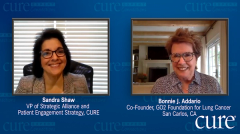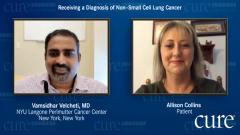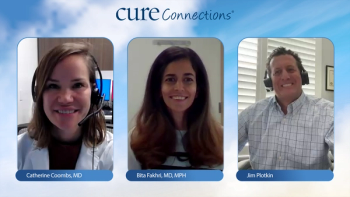
Biomarker Testing and the Impact on Treatment Selection for NSCLC
Stephen Liu, MD, and Danielle Hicks illustrate how molecular testing impacts targeted therapy selection in non-small cell lung cancer.
Episodes in this series

Stephen Liu, MD: So, when you think of biomarker testing and the impact on treatment selection, molecular testing influences things from the very beginning because we’re going in two completely different rounds that are really diametrically opposed, that are not compatible. If we find a biomarker, we’re going down the route of targeted therapy. Effective drugs [are] very safe, not necessarily cures, but [they] can be very durable, long-lasting responses. And if we don’t see one of those actual biomarkers, we’re really looking towards immunotherapy, which has the potential for very durable, meaningful responses—though, not for everyone. And we’re still trying to develop biomarkers for the use of immunotherapy, but those paths don’t really cross. We can combine those modalities. So, we need to know upfront which route we are going [down] because it’s a little hard to backtrack once we set down a specific round. That’s why early upfront testing is so important in the treatment of advanced lung cancer.
These targeted therapies, though, change how we treat lung cancer, review lung cancer. And it’s important when we think of overall prognosis, overall survival... A bunch of things need to happen. Having the biomarker is not enough. I mean, to have the biomarker, we have to find it, we have to detect it, and we have to act on it. And it turns out that we can sort of drop the ball at each step where we can sort of fail to test properly, or we can test, but maybe no one sees those results. They’re hidden in some chart, they’re sitting on some fax machine, or we know the results [are] there, but we don’t put them together. Maybe the drug is not approved, maybe they’re not aware that the drug is approved, and we give maybe a suboptimal therapy. So, all these things need to happen, and there are a lot of places along the way where things can get lost.
When I think about the biomarkers that are available today, a list that’s rapidly evolving, we’re looking at mutations, or specific changes in the DNA—in EGFR, in BRAF, in MET, in KRAS. We’re looking at gene fusions or chromosomal rearrangements, which is the same thing in ALK, in ROS1, in RET. And there are some that are on the horizon that we think will be relevant in the near future, like HER2, like NRG1, because that list continues to grow and evolve. And because there are multiple different changes within each biomarker.
For EGFR, we have common mutations. We have rare mutations. We have atypical; we have very different ones—some with very different drugs that are approved. I think comprehensive testing is the best way to ensure we’re looking for everything upfront, we’re not going to miss anything.
This is pretty detailed, and there’s a lot of information. It changes so quickly. Danielle, why is it important for patients to know about their targetable mutations?
Danielle Hicks: Yes. So, I think it’s important for patients to know about their targetable mutations, for obvious reasons. We know that if we find a target and there is an approved therapy, that the response rate is high. Right? And that they will feel better, their quality of life will improve, all of these things. I think you brought up a good point a little bit ago about really understanding biomarker testing, and I think outside of just understanding what this testing is and the purpose of this testing—and why you should have faith in that sort of waiting period being the right thing to do—is really understanding what you were just talking about.
You know, it’s not just, “Oh, I was diagnosed with non-small cell adenocarcinoma carcinoma or non-small cell adenocarcinoma with an EGFR mutation.” Maybe it’s an EGFR with an exon 20. And I think this all, again, points back to the importance of comprehension. How do you know whether or not there’s an appropriate therapy out there for you? So, I think there’s a lot of education and empowerment that needs to happen. But I can tell you, the folks that we do wind up talking to you and walking through this process [with] are incredibly grateful for the information, and that sense of control, I think, that they have over becoming educated and feeling empowered, and [we’re] like, “Okay, they can’t change the fact that they were diagnosed with cancer. They can’t control that, but they can control how they work with their physicians and move forward in the process of treating and living with that cancer.”
Stephen Liu, MD: Yeah, we’ve looked at biopsies a lot differently, even the past decade or so. Whereas before, diagnosis of lung cancer was all you needed to guide therapy. And our approach to biopsy was, as little tissue as possible, because small needle, low-risk; we don’t want any exposure from the procedure itself. Now, we’ve gone in a completely different direction, where we need a lot of tissue to make sure we’re getting the right testing. And while that may increase the risk of the procedure slightly, while it may require an extra biopsy going back and getting more tissue, it is paramount to getting the treatment right.
So, there really are wrong treatments that can be delivered if you don’t identify these. And I think the same approach is the same for rebiopsy. If we know the diagnosis of lung cancer, why would we do another biopsy? It’s not going to be something different from lung cancer, but these cancers evolve. These are moving targets. And if I give a drug that’s working well and then all of a sudden it stops working, if we didn’t change our treatment, that means the cancer must have changed in some way. And if we can identify what that change was, then maybe we can counteract it. Maybe we can adapt accordingly by sort of adjusting our treatment based on those alterations. Do you get a lot of people concerned about rebiopsy, or generally people on board with this general approach?
Danielle Hicks: So, we do. And I think whether or not people are on board with it depends on what their experience was with their first biopsy, right? And so, I think we have a lot more options now than we did fifteen, twenty years ago when it comes to biopsy in these sort of fine needle aspirations, like we’re talking about, which is so very commonly used, with EBUS [endobronchial ultrasound], and navigational bronchoscopy, and other ways that we can get down and get good quality tissue and really explaining and having those conversations with patients, I think, are an important part of this.
And I always explain to patients that if your cancer is progressing, what that means is—and I hate to use the word “smart” when it comes to cancer—but your cancer got smart, and it figured out a way that the drug was keeping it from growing. And whatever that pathway [is] that it figured out may potentially have created a new pathway that we can then go ahead and target. And I think once we explain all of that and that it really is sort of a repeat of the benefit if [the patient] had the first [biopsy], [that the patient can again have] the potential benefit that they had the first time around. Again, once you educate and empower these folks and give them this information, they are more inclined and feel better about the decisions that they’re making.
Transcript edited for clarity.




